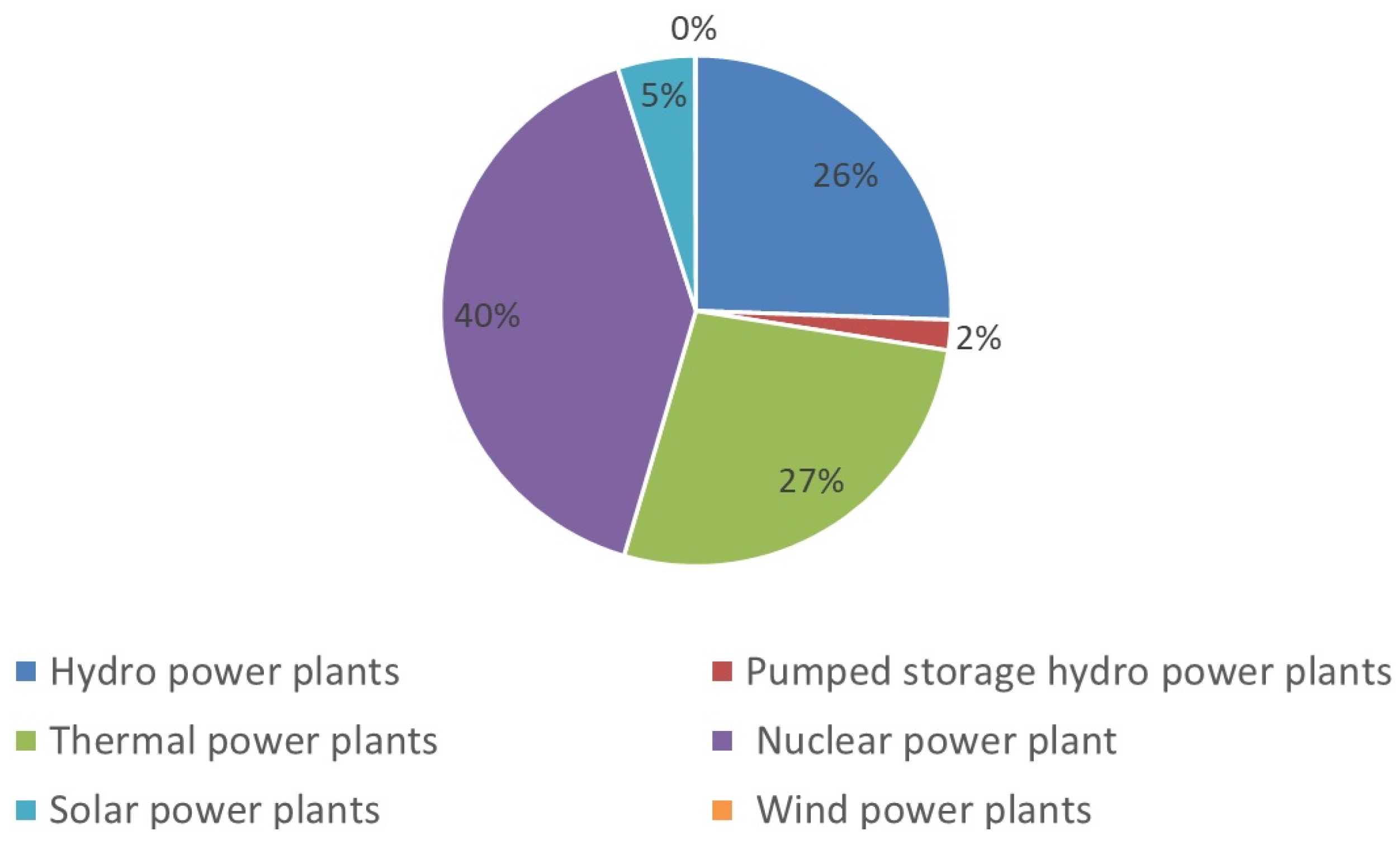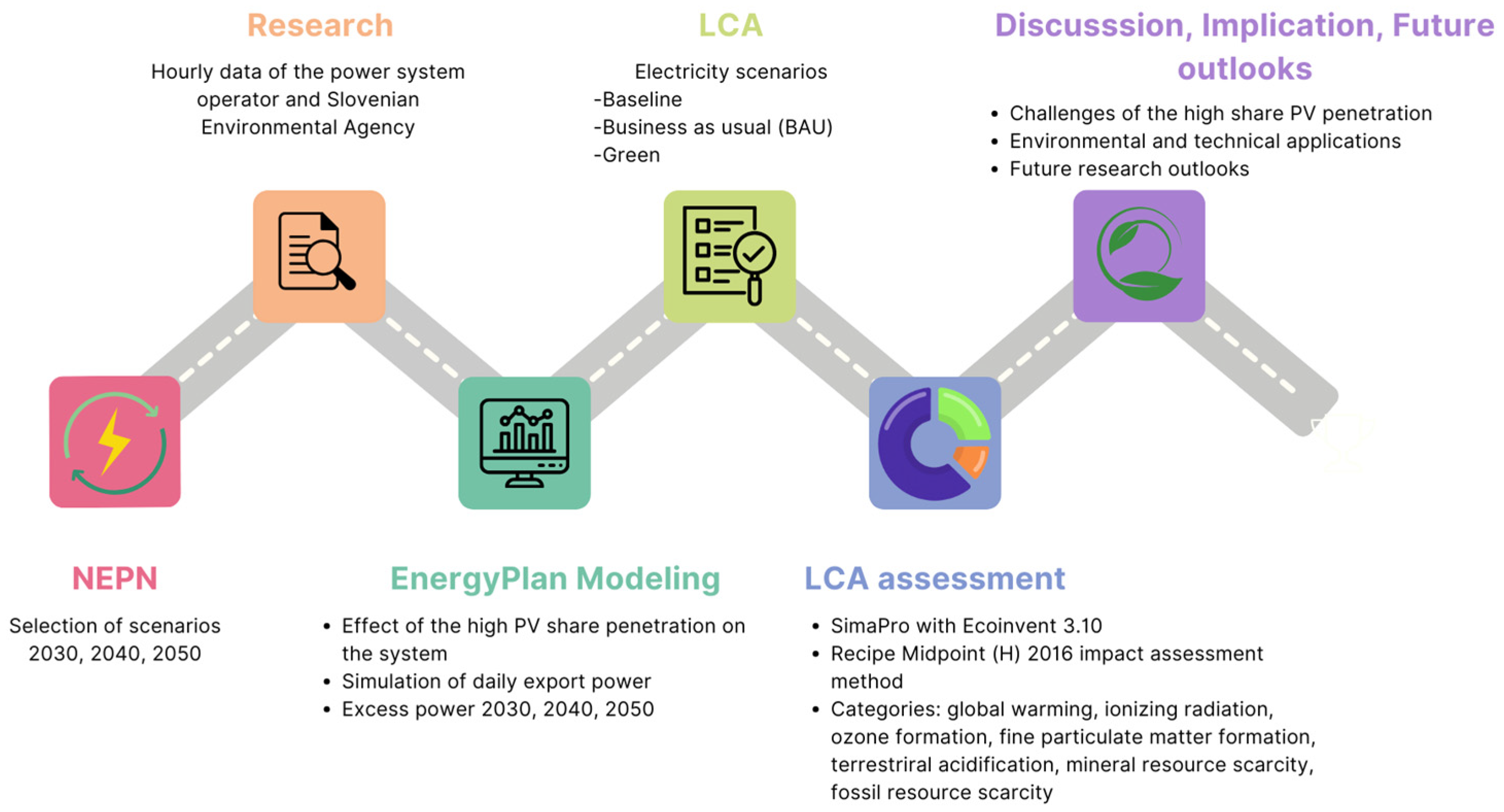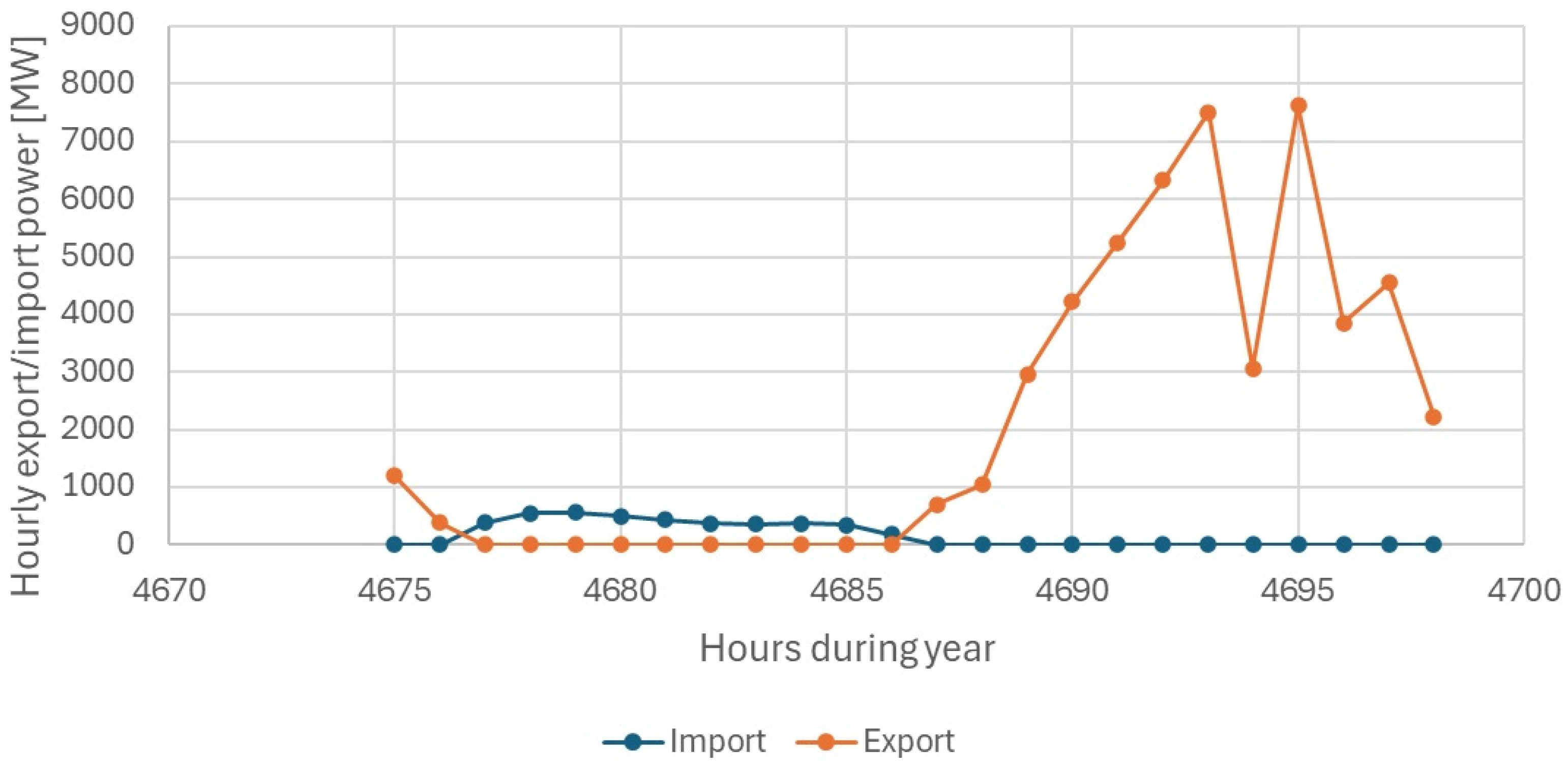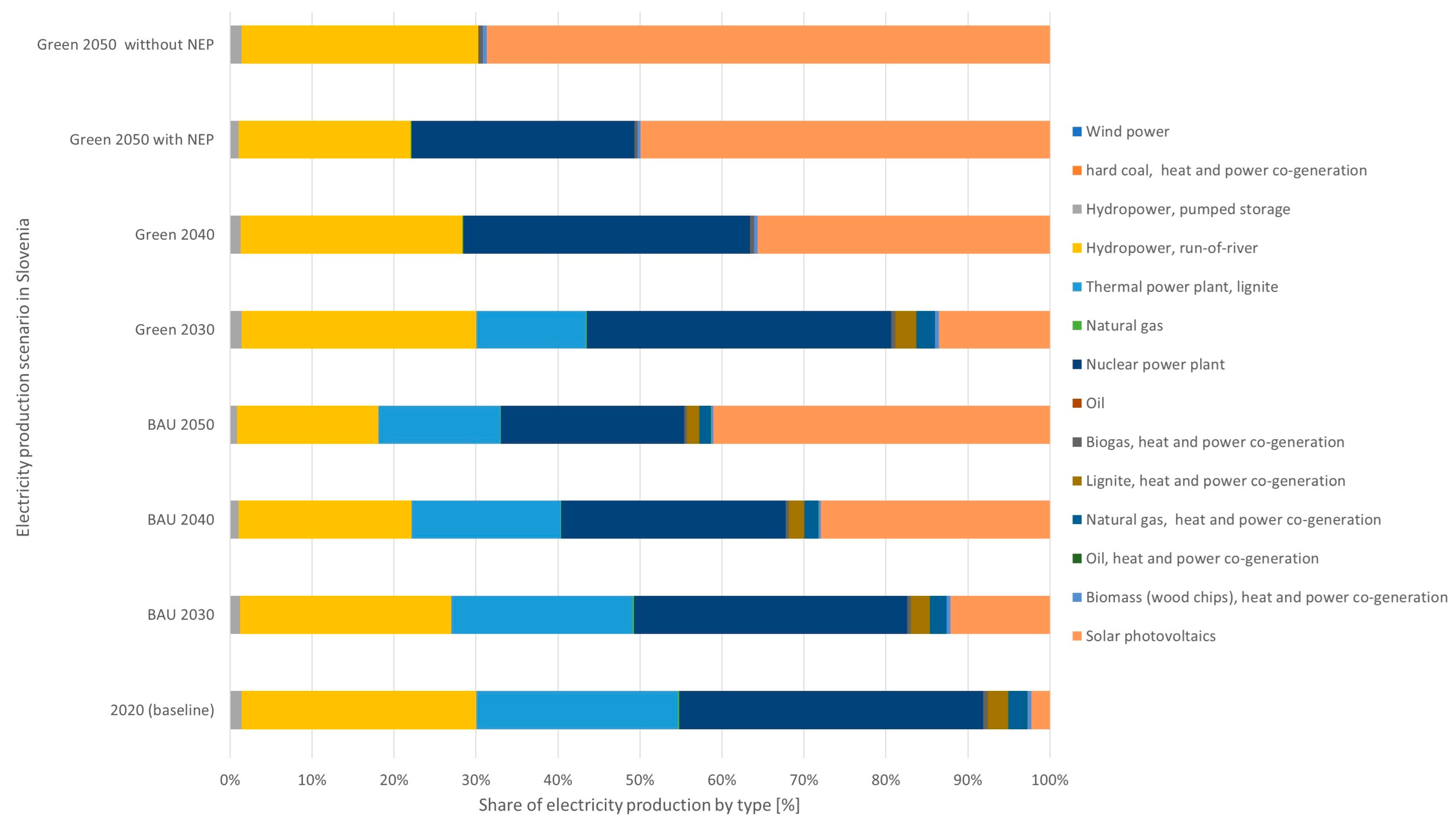Impacts of High PV Penetration on Slovenia’s Electricity Grid: Energy Modeling and Life Cycle Assessment
Abstract
1. Introduction
- Smart grids and renewable energy sources [58]
- Smart grid technology [59]
- Artificial intelligence with Blockchain distributed technology is used as a tool for studying renewable energy and related power automation [60]
- Bio-inspired optimization applications in renewable-powered smart grids [61]
- Changes in consumer behavior in case they purchase distributed solar photovoltaics and/or electric vehicles [62]
- Storage challenges and optimization [63]
- Data management related to consumer behavior [64].
2. Materials and Methods
2.1. Research Roadmap
- Selection of scenarios based on targets and data from NECP
- Energy system modeling with EnergyPlan
- LCA of electricity generation scenarios
- Interpretation of the results
2.2. Analysis of the Power Systems
- 2030 scenario: by 2030, an installation power of PV is 1800 MW and production of electricity is 2200 GWh
- 2040 scenario: by 2040, an installation power of PV is 5000 MW and production of electricity is 6160 GWh
- 2050 scenario: by 2050, an installation power of PV is 8000 MW and production of electricity is 11,090 GWh
2.3. Life Cycle Assessment of the High Share of Photovoltaics in the Electricity Production
- Baseline 2020 scenario: Total production of electricity is 16,289.6 GWh. PV share of electricity is 2.6%.
- BAU 2030 scenario: Total production of electricity is 18,121.6 GWh. PV share of electricity is 12.1%.
- BAU 2040 scenario: Total production of electricity is 27,001.6 GWh. PV share of electricity is 27.9%.
- BAU 2050 scenario: Total production of electricity is 18,121.6 GWh. PV share of electricity is 41.1%.
- Green 2030 scenario: Total production of electricity is 16,289.6 GWh. PV share of electricity is 13.5%. The scenario considers a 45.7% decrease in the production of electricity from lignite compared to the baseline scenario.
- Green 2040 scenario: Total production of electricity is 17,282.8 GWh. PV share of electricity is 35.6%. Compared to the baseline scenario, the scenario assumes phasing out electricity production from lignite by 2040.
- Green 2050 scenario with nuclear power plant in operation: Total production of electricity is 22,212.8 GWh. PV share of electricity is 49.9%. Compared to the baseline scenario, the scenario assumes phasing out electricity production from fossil-based fuels.
- Green 2050 scenario with phased out nuclear power plant (NPP) by 2050: Total production of electricity is 16,146.4 GWh. PV share of electricity is 68.7%. Compared to the baseline scenario, the scenario assumes phasing out electricity production from fossil fuels and closing down nuclear power plant by 2050.
3. Results and Discussion
3.1. Simulation of the Daily Import and Export of Photovoltaic Power
3.2. Simulation of Excess Power of the Photovoltaic System
- either conservation of some of the fossil resources used to provide system services and exporting the surplus energy or storage of the surplus energy
- or reduction in fossil energy generation and leave system services to other generation sources.
- To base or reserve electricity-generating capacity from non-sustainable sources (non-sustainable);
- To accept system stability risk and/or higher electricity prices (insecurity);
- To cede control over domestic energy rules to pursue integration with neighboring electricity grids and markets (non-autonomous).
3.3. LCA of Electricity Production Scenarios
4. Conclusions, Implications, and Future Outlooks
Author Contributions
Funding
Data Availability Statement
Conflicts of Interest
References
- Ebhota, W.S.; Jen, T.-C. Fossil Fuels Environmental Challenges and the Role of Solar Photovoltaic Technology Advances in Fast Tracking Hybrid Renewable Energy System. Int. J. Precis. Eng. Manuf. Green Technol. 2020, 7, 97–117. [Google Scholar] [CrossRef]
- Tawalbeh, M.; Al-Othman, A.; Kafiah, F.; Abdelsalam, E.; Almomani, F.; Alkasrawi, M. Environmental Impacts of Solar Photovoltaic Systems: A Critical Review of Recent Progress and Future Outlook. Sci. Total Environ. 2021, 759, 143528. [Google Scholar] [CrossRef] [PubMed]
- Żelazna, A.; Gołębiowska, J.; Zdyb, A.; Pawłowski, A. A Hybrid vs. On-Grid Photovoltaic System: Multicriteria Analysis of Environmental, Economic, and Technical Aspects in Life Cycle Perspective. Energies 2020, 13, 3978. [Google Scholar] [CrossRef]
- Farghali, M.; Osman, A.I.; Chen, Z.; Abdelhaleem, A.; Ihara, I.; Mohamed, I.M.A.; Yap, P.-S.; Rooney, D.W. Social, Environmental, and Economic Consequences of Integrating Renewable Energies in the Electricity Sector: A Review. Env. Chem. Lett. 2023, 21, 1381–1418. [Google Scholar] [CrossRef]
- Levenda, A.M.; Behrsin, I.; Disano, F. Renewable Energy for Whom? A Global Systematic Review of the Environmental Justice Implications of Renewable Energy Technologies. Energy Res. Soc. Sci. 2021, 71, 101837. [Google Scholar] [CrossRef]
- Guidi, G.; Violante, A.C.; De Iuliis, S. Environmental Impact of Electricity Generation Technologies: A Comparison between Conventional, Nuclear, and Renewable Technologies. Energies 2023, 16, 7847. [Google Scholar] [CrossRef]
- Kommalapati, R.; Kadiyala, A.; Shahriar, M.T.; Huque, Z. Review of the Life Cycle Greenhouse Gas Emissions from Different Photovoltaic and Concentrating Solar Power Electricity Generation Systems. Energies 2017, 10, 350. [Google Scholar] [CrossRef]
- Hansen, K.; Mathiesen, B.V.; Skov, I.R. Full Energy System Transition towards 100% Renewable Energy in Germany in 2050. Renew. Sustain. Energy Rev. 2019, 102, 1–13. [Google Scholar] [CrossRef]
- Pawłowski, A.; Żelazna, A.; Żak, J. Is the Polish Solar-to-Hydrogen Pathway Green? A Carbon Footprint of AEM Electrolysis Hydrogen Based on an LCA. Energies 2023, 16, 3702. [Google Scholar] [CrossRef]
- Virtič, P.; Kovačič Lukman, R. A Photovoltaic Net Metering System and Its Environmental Performance: A Case Study from Slovenia. J. Clean. Prod. 2019, 212, 334–342. [Google Scholar] [CrossRef]
- Nagaj, R.; Gajdzik, B.; Wolniak, R.; Grebski, W.W. The Impact of Deep Decarbonization Policy on the Level of Greenhouse Gas Emissions in the European Union. Energies 2024, 17, 1245. [Google Scholar] [CrossRef]
- Jaffal, H.; Guanetti, L.; Rancilio, G.; Spiller, M.; Bovera, F.; Merlo, M. Battery Energy Storage System Performance in Providing Various Electricity Market Services. Batteries 2024, 10, 69. [Google Scholar] [CrossRef]
- Morell-Dameto, N.; Chaves-Ávila, J.P.; Gómez San Román, T.; Schittekatte, T. Forward-Looking Dynamic Network Charges for Real-World Electricity Systems: A Slovenian Case Study. Energy Econ. 2023, 125, 106866. [Google Scholar] [CrossRef]
- Barros, M.V.; Salvador, R.; Piekarski, C.M.; de Francisco, A.C.; Freire, F.M.C.S. Life Cycle Assessment of Electricity Generation: A Review of the Characteristics of Existing Literature. Int. J. Life Cycle Assess 2020, 25, 36–54. [Google Scholar] [CrossRef]
- Hemeida, M.G.; Hemeida, A.M.; Senjyu, T.; Osheba, D. Renewable Energy Resources Technologies and Life Cycle Assessment: Review. Energies 2022, 15, 9417. [Google Scholar] [CrossRef]
- Krajačić, G.; Duić, N.; Carvalho, M. da G. How to Achieve a 100% RES Electricity Supply for Portugal? Appl. Energy 2011, 88, 508–517. [Google Scholar] [CrossRef]
- Esteban, M.; Portugal-Pereira, J.; Mclellan, B.C.; Bricker, J.; Farzaneh, H.; Djalilova, N.; Ishihara, K.N.; Takagi, H.; Roeber, V. 100% Renewable Energy System in Japan: Smoothening and Ancillary Services. Appl. Energy 2018, 224, 698–707. [Google Scholar] [CrossRef]
- Traber, T.; Hegner, F.S.; Fell, H.-J. An Economically Viable 100% Renewable Energy System for All Energy Sectors of Germany in 2030. Energies 2021, 14, 5230. [Google Scholar] [CrossRef]
- Connolly, D.; Lund, H.; Mathiesen, B.V.; Leahy, M. The First Step towards a 100% Renewable Energy-System for Ireland. Appl. Energy 2011, 88, 502–507. [Google Scholar] [CrossRef]
- Ćosić, B.; Krajačić, G.; Duić, N. A 100% Renewable Energy System in the Year 2050: The Case of Macedonia. Energy 2012, 48, 80–87. [Google Scholar] [CrossRef]
- Lund, H.; Mathiesen, B.V.; Liu, W.; Zhang, X.; Clark, W.W. Chapter 7—Analysis: 100 Percent Renewable Energy Systems; Renewable Energy Systems: Cohasset, MA, USA, 2014; pp. 185–238. ISBN 978-0-12-410423-5. [Google Scholar]
- Lund, H.; Mathiesen, B.V. Energy System Analysis of 100% Renewable Energy Systems—The Case of Denmark in Years 2030 and 2050. Energy 2009, 34, 524–531. [Google Scholar] [CrossRef]
- Krajačić, G.; Duić, N.; Zmijarević, Z.; Mathiesen, B.V.; Vučinić, A.A.; da Graça Carvalho, M. Planning for a 100% Independent Energy System Based on Smart Energy Storage for Integration of Renewables and CO2 Emissions Reduction. Appl. Therm. Eng. 2011, 31, 2073–2083. [Google Scholar] [CrossRef]
- Trainer, T. Can Europe Run on Renewable Energy? A Negative Case. Energy Policy 2013, 63, 845–850. [Google Scholar] [CrossRef]
- Trainer, T. Some Problems in Storing Renewable Energy. Energy Policy 2017, 110, 386–393. [Google Scholar] [CrossRef]
- Heard, B.P.; Brook, B.W.; Wigley, T.M.L.; Bradshaw, C.J.A. Burden of Proof: A Comprehensive Review of the Feasibility of 100% Renewable-Electricity Systems. Renew. Sustain. Energy Rev. 2017, 76, 1122–1133. [Google Scholar] [CrossRef]
- Mlilo, N.; Brown, J.; Ahfock, T. Impact of Intermittent Renewable Energy Generation Penetration on the Power System Networks—A Review. Technol. Econ. Smart Grids Sustain. Energy 2021, 6, 25. [Google Scholar] [CrossRef]
- Glasnovic, Z.; Margeta, J. Sustainable Electric Power System: Is It Possible? Case Study: Croatia. J. Energy Eng. 2010, 136, 103–113. [Google Scholar] [CrossRef]
- Vukobratovic, M.; Sljivac, D.; Nikolovski, S.; StaniC, Z.; Knezevic, S. Energy Potential and so Far Course of Action of Using Biomass and Biogas in Croatia. In Proceedings of the CIRED 2009—20th International Conference and Exhibition on Electricity Distribution—Part 1, Prague, Czech Republic, 8–11 June 2009; pp. 1–7. [Google Scholar]
- Olowu, T.O.; Sundararajan, A.; Moghaddami, M.; Sarwat, A.I. Future Challenges and Mitigation Methods for High Photovoltaic Penetration: A Survey. Energies 2018, 11, 1782. [Google Scholar] [CrossRef]
- Hossain, M.S.; Abboodi Madlool, N.; Al-Fatlawi, A.W.; El Haj Assad, M. High Penetration of Solar Photovoltaic Structure on the Grid System Disruption: An Overview of Technology Advancement. Sustainability 2023, 15, 1174. [Google Scholar] [CrossRef]
- Thaler, P.; Hofmann, B. The Impossible Energy Trinity: Energy Security, Sustainability, and Sovereignty in Cross-Border Electricity Systems. Political Geogr. 2022, 94, 102579. [Google Scholar] [CrossRef]
- Khoo, H.H. LCA of Mixed Generation Systems in Singapore: Implications for National Policy Making. Energies 2022, 15, 9272. [Google Scholar] [CrossRef]
- Gargiulo, A.; Carvalho, M.L.; Girardi, P. Life Cycle Assessment of Italian Electricity Scenarios to 2030. Energies 2020, 13, 3852. [Google Scholar] [CrossRef]
- Ghisellini, P.; Passaro, R.; Ulgiati, S. Environmental Assessment of Multiple “Cleaner Electricity Mix” Scenarios within Just Energy and Circular Economy Transitions, in Italy and Europe. J. Clean. Prod. 2023, 388, 135891. [Google Scholar] [CrossRef]
- Ramirez, A.D.; Boero, A.; Rivela, B.; Melendres, A.M.; Espinoza, S.; Salas, D.A. Life Cycle Methods to Analyze the Environmental Sustainability of Electricity Generation in Ecuador: Is Decarbonization the Right Path? Renew. Sustain. Energy Rev. 2020, 134, 110373. [Google Scholar] [CrossRef]
- Garcia, R.; Marques, P.; Freire, F. Life-Cycle Assessment of Electricity in Portugal. Appl. Energy 2014, 134, 563–572. [Google Scholar] [CrossRef]
- San Miguel, G.; Cerrato, M. Life Cycle Sustainability Assessment of the Spanish Electricity: Past, Present and Future Projections. Energies 2020, 13, 1896. [Google Scholar] [CrossRef]
- Slovenian Ministry for Infrastructure. National Action Plan for Renewable Energy Sources (AP-RES) 2010–2020—2017 Update; Slovenian Ministry for Infrastructure: Ljubljana, Slovenia, 2017.
- Slovenian Energy Agency. Report on the Energy Secotr in SLovenia 2020; Slovenian Energy Agency: Maribor, Slovenia, 2020. [Google Scholar]
- Senegačnik, A.; Stropnik, R.; Sekavčnik, M.; Oprešnik, S.R.; Mlakar, U.; Ivanjko, Š.; Stritih, U. Integration of Renewable Energy Sources for Sustainable Energy Development in Slovenia till 2050. Sustain. Cities Soc. 2023, 96, 104668. [Google Scholar] [CrossRef]
- Maris, G.; Flouros, F. The Green Deal, National Energy and Climate Plans in Europe: Member States’ Compliance and Strategies. Adm. Sci. 2021, 11, 75. [Google Scholar] [CrossRef]
- Government of the Republic of Slovenia. Integrated National Energy and Climate Plan of the Republic of Slovenia; Government of the Republic of Slovenia: Ljubljana, Slovenia, 2020.
- Dimnik, J.; Novak, P.; Muhic, S. Decarbonising Power System with High Share of Renewables and Optionally with or without Nuclear: Slovenia Case. Therm. Sci. 2022, 26, 1593–1602. [Google Scholar] [CrossRef]
- Government of the Republic of Slovenia. Slovenia—Draft Updated NECP 2021–2030; Government of the Republic of Slovenia: Ljubljana, Slovenia, 2023.
- Slovenian Energy Agency. Report on the Energy Situation in Slovenia 2022; Slovenian Energy Agency: Maribor, Slovenia, 2022.
- SURS Energy Statistics. 2022. Available online: https://www.stat.si/StatWeb/en/News/Index/11405 (accessed on 12 April 2024).
- Rynska, E. Review of PV Solar Energy Development 2011–2021 in Central European Countries. Energies 2022, 15, 8307. [Google Scholar] [CrossRef]
- Crnčec, D.; Sučić, B.; Merše, S. Slovenia: Drivers and Challenges of Energy Transition to Climate Neutrality. In From Economic to Energy Transition: Three Decades of Transitions in Central and Eastern Europe; Mišík, M., Oravcová, V., Eds.; Springer International Publishing: Cham, Switzerland, 2021; pp. 247–282. ISBN 978-3-030-55085-1. [Google Scholar]
- ARSO Subsidies in the Energy Sector|Okoljski Kazalci. Available online: https://kazalci.arso.gov.si/index.php/en/content/subsidies-energy-sector-2?tid=25 (accessed on 10 May 2024).
- Tratnik, E.; Beković, M. Empowering Active Users: A Case Study with Economic Analysis of the Electric Energy Cost Calculation Post-Net-Metering Abolition in Slovenia. Energies 2024, 17, 1501. [Google Scholar] [CrossRef]
- Rihl, F. An Overview of Ragulations Regarding Photovoltaic Systems in Slovenia. J. Energy Technol. 2016, 9, 39. [Google Scholar]
- Obrecht, M.; Denac, M.; Furjan, P.; Delcnjak, M. Evaluation and Analysis of Renewable Energy Sources Potential in Slovenia and its Compatibility Examination with Slovenian National Renewable Energy Action Plan; LiU Electronic Press: Linköping, Sweden, 2011. [Google Scholar]
- Yin, J.; Molini, A.; Porporato, A. Impacts of Solar Intermittency on Future Photovoltaic Reliability. Nat. Commun. 2020, 11, 4781. [Google Scholar] [CrossRef] [PubMed]
- Asiaban, S.; Kayedpour, N.; Samani, A.E.; Bozalakov, D.; De Kooning, J.D.M.; Crevecoeur, G.; Vandevelde, L. Wind and Solar Intermittency and the Associated Integration Challenges: A Comprehensive Review Including the Status in the Belgian Power System. Energies 2021, 14, 2630. [Google Scholar] [CrossRef]
- Guerra, K.; Haro, P.; Gutiérrez, R.E.; Gómez-Barea, A. Facing the High Share of Variable Renewable Energy in the Power System: Flexibility and Stability Requirements. Appl. Energy 2022, 310, 118561. [Google Scholar] [CrossRef]
- Alsirhani, A.; Mujib Alshahrani, M.; Abukwaik, A.; Taloba, A.I.; Abd El-Aziz, R.M.; Salem, M. A Novel Approach to Predicting the Stability of the Smart Grid Utilizing MLP-ELM Technique. Alex. Eng. J. 2023, 74, 495–508. [Google Scholar] [CrossRef]
- Kataray, T.; Nitesh, B.; Yarram, B.; Sinha, S.; Cuce, E.; Shaik, S.; Vigneshwaran, P.; Roy, A. Integration of Smart Grid with Renewable Energy Sources: Opportunities and Challenges—A Comprehensive Review. Sustain. Energy Technol. Assess. 2023, 58, 103363. [Google Scholar] [CrossRef]
- Majeed Butt, O.; Zulqarnain, M.; Majeed Butt, T. Recent Advancement in Smart Grid Technology: Future Prospects in the Electrical Power Network. Ain. Shams Eng. J. 2021, 12, 687–695. [Google Scholar] [CrossRef]
- Ayub Khan, A.; Ali Laghari, A.; Rashid, M.; Li, H.; Rehman Javed, A.; Reddy Gadekallu, T. Artificial Intelligence and Blockchain Technology for Secure Smart Grid and Power Distribution Automation: A State-of-the-Art Review. Sustain. Energy Technol. Assess. 2023, 57, 103282. [Google Scholar] [CrossRef]
- Pop, C.B.; Cioara, T.; Anghel, I.; Antal, M.; Chifu, V.R.; Antal, C.; Salomie, I. Review of Bio-Inspired Optimization Applications in Renewable-Powered Smart Grids: Emerging Population-Based Metaheuristics. Energy Rep. 2022, 8, 11769–11798. [Google Scholar] [CrossRef]
- Liang, J.; Qiu, Y.; Xing, B. Impacts of the Co-Adoption of Electric Vehicles and Solar Panel Systems: Empirical Evidence of Changes in Electricity Demand and Consumer Behaviors from Household Smart Meter Data. Energy Econ. 2022, 112, 106170. [Google Scholar] [CrossRef]
- Ji, H.; Wang, H.; Yang, J.; Feng, J.; Yang, Y.; Okoye, M.O. Optimal Schedule of Solid Electric Thermal Storage Considering Consumer Behavior Characteristics in Combined Electricity and Heat Networks. Energy 2021, 234, 121237. [Google Scholar] [CrossRef]
- Oprea, S.-V.; Bâra, A.; Tudorică, B.G.; Călinoiu, M.I.; Botezatu, M.A. Insights into Demand-Side Management with Big Data Analytics in Electricity Consumers’ Behaviour. Comput. Electr. Eng. 2021, 89, 106902. [Google Scholar] [CrossRef]
- Huber, D.; Costa, D.; Felice, A.; Valkering, P.; Coosemans, T.; Messagie, M. Decentralized Energy in Flexible Energy System: Life Cycle Environmental Impacts in Belgium. Sci. Total Environ. 2023, 886, 163882. [Google Scholar] [CrossRef] [PubMed]
- Zappa, W.; Junginger, M.; van den Broek, M. Is a 100% Renewable European Power System Feasible by 2050? Appl. Energy 2019, 233–234, 1027–1050. [Google Scholar] [CrossRef]
- Gerkšič, S.; Vrančić, D.; Čalič, D.; Žerovnik, G.; Trkov, A.; Kromar, M.; Snoj, L. A Perspective of Using Nuclear Power as a Dispatchable Power Source for Covering the Daily Fluctuations of Solar Power. Energy 2023, 284, 128531. [Google Scholar] [CrossRef]
- Sadhukhan, J. Net Zero Electricity Systems in Global Economies by Life Cycle Assessment (LCA) Considering Ecosystem, Health, Monetization, and Soil CO2 Sequestration Impacts. Renew. Energy 2022, 184, 960–974. [Google Scholar] [CrossRef]
- Lopion, P.; Markewitz, P.; Robinius, M.; Stolten, D. A Review of Current Challenges and Trends in Energy Systems Modeling. Renew. Sustain. Energy Rev. 2018, 96, 156–166. [Google Scholar] [CrossRef]
- Liu, W.; Lund, H.; Mathiesen, B.V. Large-Scale Integration of Wind Power into the Existing Chinese Energy System. Energy 2011, 36, 4753–4760. [Google Scholar] [CrossRef]
- Østergaard, P.A. Reviewing EnergyPLAN Simulations and Performance Indicator Applications in EnergyPLAN Simulations. Appl. Energy 2015, 154, 921–933. [Google Scholar] [CrossRef]
- Lund, H.; Thellufsen, J.Z.; Østergaard, P.A.; Sorknæs, P.; Skov, I.R.; Mathiesen, B.V. EnergyPLAN—Advanced Analysis of Smart Energy Systems. Smart Energy 2021, 1, 100007. [Google Scholar] [CrossRef]
- Fattahi, A.; Sijm, J.; Faaij, A. A Systemic Approach to Analyze Integrated Energy System Modeling Tools: A Review of National Models. Renew. Sustain. Energy Rev. 2020, 133, 110195. [Google Scholar] [CrossRef] [PubMed]
- SEPRG EnergyPLAN|Advanced Energy Systems Analysis Computer Model. Available online: https://energyplan2.aau.dk/ (accessed on 14 March 2024).
- ELES. Razvojni Načrt Prenosnega Sistema Republike Slovenije Za Obdobje 2023–2032; ELES: Todi, Italy, 2023. [Google Scholar]
- ELES Prevzem in Proizvodnja|Eles d.o.o. Available online: https://www.eles.si/prevzem-in-proizvodnja (accessed on 14 March 2024).
- ARSO Meteo.Si—National Meteorological Service of Slovenia. Available online: https://meteo.arso.gov.si/met/en/ (accessed on 14 March 2024).
- CRVE Priprava Strokovnih Podlag Za Določitev Nacionalnih Potencialov Za Pogajanja z Evropsko Komisijo o Določitvi Nacionalnih Ciljev; Fakulteta za elektrotehniko: Ljubljana, Slovenia, 2007.
- Muralikrishna, I.V.; Manickam, V. Chapter Five—Life Cycle Assessment. In Environmental Management; Muralikrishna, I.V., Manickam, V., Eds.; Butterworth-Heinemann: Oxford, UK, 2017; pp. 57–75. ISBN 978-0-12-811989-1. [Google Scholar]
- Sütterlin, B.; Siegrist, M. Public Acceptance of Renewable Energy Technologies from an Abstract versus Concrete Perspective and the Positive Imagery of Solar Power. Energy Policy 2017, 106, 356–366. [Google Scholar] [CrossRef]
- Kurdija, S.; Bevk, T. Podnebne Spremembe in Odnos Javnostido Rabe Obnovljivih Virov Energije. TIP 2023, 60, 691–716. [Google Scholar] [CrossRef]
- Bonilla-Campos, I.; Sorbet Fco, J.; Astrain, D. Radical Change in the Spanish Grid: Renewable Energy Generation Profile and Electric Energy Excess. Sustain. Energy Grids Netw. 2022, 32, 100941. [Google Scholar] [CrossRef]
- Liu, B.; Lund, J.R.; Liao, S.; Jin, X.; Liu, L.; Cheng, C. Optimal Power Peak Shaving Using Hydropower to Complement Wind and Solar Power Uncertainty. Energy Convers. Manag. 2020, 209, 112628. [Google Scholar] [CrossRef]
- Javed, M.S.; Ma, T.; Jurasz, J.; Amin, M.Y. Solar and Wind Power Generation Systems with Pumped Hydro Storage: Review and Future Perspectives. Renew. Energy 2020, 148, 176–192. [Google Scholar] [CrossRef]
- Hunt, J.D.; Zakeri, B.; Lopes, R.; Barbosa, P.S.F.; Nascimento, A.; de Castro, N.J.; Brandão, R.; Schneider, P.S.; Wada, Y. Existing and New Arrangements of Pumped-Hydro Storage Plants. Renew. Sustain. Energy Rev. 2020, 129, 109914. [Google Scholar] [CrossRef]
- Rahman, A.; Farrok, O.; Haque, M.M. Environmental Impact of Renewable Energy Source Based Electrical Power Plants: Solar, Wind, Hydroelectric, Biomass, Geothermal, Tidal, Ocean, and Osmotic. Renew. Sustain. Energy Rev. 2022, 161, 112279. [Google Scholar] [CrossRef]
- Hočevar, M.; Novak, L.; Drešar, P.; Rak, G. The Status Quo and Future of Hydropower in Slovenia. Energies 2022, 15, 6977. [Google Scholar] [CrossRef]
- Licastro, A.; Sergi, B.S. Drivers and Barriers to a Green Economy. A Review of Selected Balkan Countries. Clean. Eng. Technol. 2021, 4, 100228. [Google Scholar] [CrossRef]
- Zapata, S.; Castaneda, M.; Franco, C.J.; Dyner, I. Clean and Secure Power Supply: A System Dynamics Based Appraisal. Energy Policy 2019, 131, 9–21. [Google Scholar] [CrossRef]
- Zsiborács, H.; Baranyai, N.H.; Vincze, A.; Zentkó, L.; Birkner, Z.; Máté, K.; Pintér, G. Intermittent Renewable Energy Sources: The Role of Energy Storage in the European Power System of 2040. Electronics 2019, 8, 729. [Google Scholar] [CrossRef]
- Lokar, J.; Virtič, P. The Potential for Integration of Hydrogen for Complete Energy Self-Sufficiency in Residential Buildings with Photovoltaic and Battery Storage Systems. Int. J. Hydrogen Energy 2020, 45, 34566–34578. [Google Scholar] [CrossRef]
- Sadhukhan, J.; Christensen, M. An In-Depth Life Cycle Assessment (LCA) of Lithium-Ion Battery for Climate Impact Mitigation Strategies. Energies 2021, 14, 5555. [Google Scholar] [CrossRef]
- Sasse, J.-P.; Trutnevyte, E. Cost-Effective Options and Regional Interdependencies of Reaching a Low-Carbon European Electricity System in 2035. Energy 2023, 282, 128774. [Google Scholar] [CrossRef]
- Tröndle, T.; Lilliestam, J.; Marelli, S.; Pfenninger, S. Trade-Offs between Geographic Scale, Cost, and Infrastructure Requirements for Fully Renewable Electricity in Europe. Joule 2020, 4, 1929–1948. [Google Scholar] [CrossRef]
- García-Gusano, D.; Garraín, D.; Dufour, J. Prospective Life Cycle Assessment of the Spanish Electricity Production. Renew. Sustain. Energy Rev. 2017, 75, 21–34. [Google Scholar] [CrossRef]
- Rakotoson, V.; Praene, J.P. A Life Cycle Assessment Approach to the Electricity Generation of French Overseas Territories. J. Clean. Prod. 2017, 168, 755–763. [Google Scholar] [CrossRef]
- Jones, C.; Gilbert, P.; Raugei, M.; Mander, S.; Leccisi, E. An Approach to Prospective Consequential Life Cycle Assessment and Net Energy Analysis of Distributed Electricity Generation. Energy Policy 2017, 100, 350–358. [Google Scholar] [CrossRef]
- Turconi, R.; Tonini, D.; Nielsen, C.F.B.; Simonsen, C.G.; Astrup, T. Environmental Impacts of Future Low-Carbon Electricity Systems: Detailed Life Cycle Assessment of a Danish Case Study. Appl. Energy 2014, 132, 66–73. [Google Scholar] [CrossRef]
- Bach, V. Life Cycle Assessment in the Context of Decarbonization and Carbon Neutrality. Int. J. Life Cycle Assess 2023, 28, 741–745. [Google Scholar] [CrossRef]





| Impact Category | Unit | Baseline 2020 | BAU 2030 | BAU 2040 | BAU 2050 | Green 2030 | Green 2040 | Green 2050 | Green 2050 without NPP |
|---|---|---|---|---|---|---|---|---|---|
| Global warming | kg CO2 eq | 0.3626 | 0.3345 | 0.2899 | 0.2526 | 0.2361 | 0.0663 | 0.0706 | 0.0687 |
| Ionizing radiation | kBq Co-60 eq | 0.2635 | 0.2375 | 0.1960 | 0.1614 | 0.2626 | 0.2482 | 0.1945 | 0.0083 |
| Ozone formation, Human health | kg NOx eq | 0.0009 | 0.0008 | 0.0007 | 0.0006 | 0.0006 | 0.0002 | 0.0002 | 0.0002 |
| Fine particulate matter formation | kg PM2.5 eq | 0.0020 | 0.0018 | 0.0015 | 0.0013 | 0.0012 | 0.0003 | 0.0003 | 0.0002 |
| Ozone formation, Terrestrial ecosystems | kg NOx eq | 0.0009 | 0.0008 | 0.0007 | 0.0006 | 0.0006 | 0.0002 | 0.0002 | 0.0002 |
| Terrestrial acidification | kg SO2 eq | 0.0062 | 0.0057 | 0.0048 | 0.0040 | 0.0038 | 0.0007 | 0.0007 | 0.0005 |
| Mineral resource scarcity | kg Cu eq | 0.0004 | 0.0006 | 0.0008 | 0.0010 | 0.0006 | 0.0010 | 0.0012 | 0.0014 |
| Fossil resource scarcity | kg oil eq | 0.0787 | 0.0729 | 0.0637 | 0.0560 | 0.0525 | 0.0153 | 0.0166 | 0.0168 |
Disclaimer/Publisher’s Note: The statements, opinions and data contained in all publications are solely those of the individual author(s) and contributor(s) and not of MDPI and/or the editor(s). MDPI and/or the editor(s) disclaim responsibility for any injury to people or property resulting from any ideas, methods, instructions or products referred to in the content. |
© 2024 by the authors. Licensee MDPI, Basel, Switzerland. This article is an open access article distributed under the terms and conditions of the Creative Commons Attribution (CC BY) license (https://creativecommons.org/licenses/by/4.0/).
Share and Cite
Dimnik, J.; Topić Božič, J.; Čikić, A.; Muhič, S. Impacts of High PV Penetration on Slovenia’s Electricity Grid: Energy Modeling and Life Cycle Assessment. Energies 2024, 17, 3170. https://doi.org/10.3390/en17133170
Dimnik J, Topić Božič J, Čikić A, Muhič S. Impacts of High PV Penetration on Slovenia’s Electricity Grid: Energy Modeling and Life Cycle Assessment. Energies. 2024; 17(13):3170. https://doi.org/10.3390/en17133170
Chicago/Turabian StyleDimnik, Jože, Jelena Topić Božič, Ante Čikić, and Simon Muhič. 2024. "Impacts of High PV Penetration on Slovenia’s Electricity Grid: Energy Modeling and Life Cycle Assessment" Energies 17, no. 13: 3170. https://doi.org/10.3390/en17133170
APA StyleDimnik, J., Topić Božič, J., Čikić, A., & Muhič, S. (2024). Impacts of High PV Penetration on Slovenia’s Electricity Grid: Energy Modeling and Life Cycle Assessment. Energies, 17(13), 3170. https://doi.org/10.3390/en17133170







